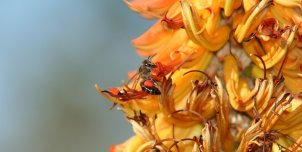Conservation
The conservation benefits of the project are significant. When spekboom blankets the landscape, biodiversity increases dramatically. In addition to a wide range of mammals, birds and insects, the project will help to conserve the black rhinoceros and African elephant, which have been placed on the IUCN Red List of Critically Endangered species.
Once the spekboom cuttings start growing, new topsoil is generated as the trees shed their leaves and as the earthworms in these ecosystems return to eat the leaf litter. As the topsoils regenerate, other plants move back into the ecosystem and animals return.
Thicket restoration will also stop the extreme erosion of soil into rivers and dams. In the degraded desert landscape, rain falls on a hard brown surface and runs off quickly. In restored spekboom thicket, rainwater soaks into dark rich soils and flows slowly into deep aquifers that then release water into streams and rivers. Even in the dry season, the rivers will flow. The restored landscape acts like a green sponge rather than a brown concrete-like slab. Consequently, the overall functioning of water catchments will be improved.




Recent Comments